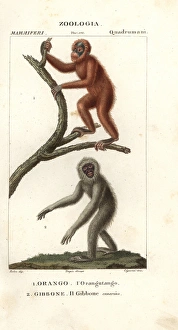Hylobates Collection
Hylobates: Guardians of the Canopy In a world where man and ape share an uncanny resemblance, the hylobates swing gracefully through the treetops
All Professionally Made to Order for Quick Shipping
Hylobates: Guardians of the Canopy In a world where man and ape share an uncanny resemblance, the hylobates swing gracefully through the treetops. These magnificent creatures, known as gibbons, captivate us with their agile movements and striking appearances. Among them is the white-handed or lar gibbon (Hylobates lar), whose existence hangs by a thread on the endangered species list. Its delicate frame and gentle demeanor make it all the more precious in our eyes. Similarly threatened are its cousins, the siamang and agile gibbon, both struggling to survive in their diminishing habitats. One cannot help but be enchanted by these active gibbons, especially when observing a female Hylobates agilis fearlessly leaping from branch to branch. Her bravery echoes that of her fellow Western hoolock gibbon (Hoolock hoolock), who valiantly fights against extinction. Even in death, these remarkable creatures continue to fascinate us. The skeletons of agile gibbons serve as haunting reminders of their endangered status - fragile yet resilient symbols of a battle for survival. Throughout history, humans have formed unique connections with gibbons. Osa and Martin Johnson found solace amidst London Zoo's orangutan and gibbon companionship. In 1897's Anthropoidea illustration, hylobates stand out among other primates – their red hue representing vitality while reminding us of our shared ancestry. With long arms built for swinging effortlessly through dense forests, hylobates prove themselves as true masters of arboreal life. Their adaptability allows them to navigate even the most challenging environments with grace and ease. As we witness these captivating creatures teetering on the brink of extinction due to habitat loss and poaching pressures, it becomes clear that we must act swiftly to protect them before they disappear forever. Let us join forces in preserving not only their physical presence but also their vital role within our planet's delicate ecosystem.


























